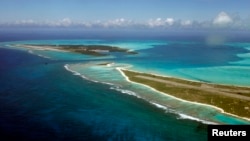Talk of climate change always includes a warning about melting icecaps, which will raise sea levels and threaten island nations and coastal communities. But a new analysis by the U.S. Geological Survey says those warnings are not dire enough.
The computer projections typically used to predict sea-level rise are based on map data and simple rising-water models, which suggest that most of the low-lying Pacific atolls will remain above sea level for the next 50-150 years. The new forecast takes storm-driven wind and wave actions into account, leading to a scenario that has many of the atolls inundated and uninhabitable much sooner.
USGS oceanographer Curt Storlazzi studied Midway and Laysan atolls, which have coastal features common to many Pacific islands. His team determined that 91 percent of Midway's Eastern Island would be under water with a sea level rise of 2 meters, compared to the earlier forecast of 19 percent.
Storlazzi said the findings have importance for the tens of thousands of people who live on other low-lying islands, and offer tools for forecasting where agricultural land may be damaged by repeated overwash from the ocean, and where inland groundwater may be contaminated by saltwater.
The computer projections typically used to predict sea-level rise are based on map data and simple rising-water models, which suggest that most of the low-lying Pacific atolls will remain above sea level for the next 50-150 years. The new forecast takes storm-driven wind and wave actions into account, leading to a scenario that has many of the atolls inundated and uninhabitable much sooner.
USGS oceanographer Curt Storlazzi studied Midway and Laysan atolls, which have coastal features common to many Pacific islands. His team determined that 91 percent of Midway's Eastern Island would be under water with a sea level rise of 2 meters, compared to the earlier forecast of 19 percent.
Storlazzi said the findings have importance for the tens of thousands of people who live on other low-lying islands, and offer tools for forecasting where agricultural land may be damaged by repeated overwash from the ocean, and where inland groundwater may be contaminated by saltwater.





